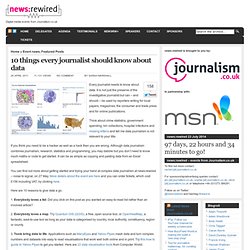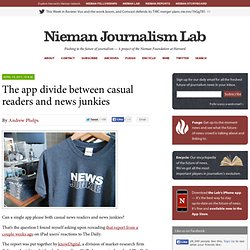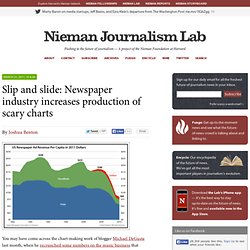

Could data save newspapers? 01 November 2011 · By Kylie Davis The news that the world is entering a new era of “Big Data” is likely to offend many die hard traditionalists in newsrooms, who are still enraged by the Internet making the word “content” a synonym for journalism.

Twitter Dispute at Reuters Is Resolved - Nolo's Employment Law Blog. The AOL-TechCrunch Investing Controversy. Would it surprise you to know that BoomTown doesn’t really care anymore if TechCrunch editor Michael Arrington sidelines as a blogger while he makes investments in tech companies his tech news site covers?

In a post yesterday, titled “An Update to My Investment Policy,” Arrington made his seemingly cogent arguments that plenty of disclosure made it all “fine,” took one of his typical look-at-me swipes at anyone who dared to question this logic (apparently, we’re crappy “direct” competitors, so we haters have no standing to comment!) And presumably went on his merry investing way.
While I was first irked–because it was an appalling show to many of us cranky standards-insisting whiners–I soon realized Arrington had made a good argument about who he is and, frankly, who he has always been. In other words, it’s a kind of there-he-goes-again thing, vaguely icky but hardly surprising and completely genuine. The newsonomics of story cost accounting. Some MSU faculty wary of outsourcing. Blog Archive » 10 things every journalist should know about data. Every journalist needs to know about data.

It is not just the preserve of the investigative journalist but can – and should – be used by reporters writing for local papers, magazines, the consumer and trade press and for online publications. Think about crime statistics, government spending, bin collections, hospital infections and missing kittens and tell me data journalism is not relevant to your title. If you think you need to be a hacker as well as a hack then you are wrong. Although data journalism combines journalism, research, statistics and programming, you may dabble but you don’t need to know much maths or code to get started. It can be as simple as copying and pasting data from an Excel spreadsheet. You can find out more about getting started and trying your hand at complex data journalism at news:rewired – noise to signal, on 27 May. The newsonomics of oblivion.
Editor’s Note: Each week, Ken Doctor — author of Newsonomics and longtime watcher of the business side of digital news — writes about the economics of news for the Lab.
The Top 25 Newspapers on Twitter. The New York Times is by far the most followed, but shows the smallest growth; the Chicago Tribune and San Francisco Chronicle are gaining Last fall, the blog Journalistics published a list ranking the top 25 newspapers on Twitter, based on their follower counts.

(TheWrap followed up with a similar list for magazines.) The New York Times’ R&D Lab has built a tool that explores the life stories take in the social space. Some of the most exciting work taking place in The New York Times building is being done on the 28th floor, in the paper’s Research and Development Lab.

The group serves essentially as a skunkworks project for a news institution that stands to benefit, financially and otherwise, from creative thinking; as Michael Zimbalist, the Times’ vice president of R&D, puts it, the team is “investigating the ideas at the edges of today and thinking about how they’re going to impact business decisions tomorrow.” (For more on the group’s doings, check out the series of videos that we shot there a couple of years ago.) The app divide between casual readers and news junkies. Can a single app please both casual news readers and news junkies?

That’s the question I found myself asking upon rereading that report from a couple weeks ago on iPad users’ reactions to The Daily. The report was put together by knowDigital, a division of market-research firm Coleman Insights, which asked more than 40 iPad owners to download The Daily and use it for two weeks. Slip and slide: Newspaper industry increases production of scary charts. You may have come across the chart-making work of blogger Michael DeGusta last month, when he recrunched some numbers on the music business that illustrated that industry’s financial decline.

And now he’s cast his axis-loving eyes upon the newspaper business and, in particular, the Newspaper Association of America’s release last week of 2010 advertising revenue numbers. The result is what you see above, which (a) gathers together NAA ad revenue totals since 1980, (b) adjusts for inflation, putting it all in 2011 dollars, and (c) adjusts for population growth, making the dollar figures per capita. So each point in the chart indicates how much ad money the newspaper industry made from the average resident of the United States per year. (And, to repeat, everything in this chart and this post covers only advertising revenue, not overall revenue — so circulation money isn’t included. Although that hasn’t exactly been a great multidecade success story, either.)